The Communications and Information network Association of Japan (CIAJ) announced its “FY2016 Report on the Study of the IoT Market (tentative translation).”
CIAJ has been promoting the spread of the IoT society as part of its effort to create new markets. Accurately grasping trends is crucial for gaining new market entry and market share in the growing IoT market. Thus, CIAJ has conducted a study to analyze the evolving IoT market by relevant categories and has released the findings in a report.
1. Summary
For the purpose of this study, the “IoT ratio” was defined as the percentage of “IoT devices” with the ability to connect to the network against all devices, which includes those that are not IoT compatible. It can be assumed that industries and device categories with low IoT ratios have growth potential.
Globally, there were approximately 5.4 billion devices worth about 600 billion US dollars (both 2015 figures) shipped as “IoT devices” that would be included in the categories covered in the study. This would amount to only about 20% IoT ratio. Both the number of devices and “IoT ratio” are expected to grow, meaning that it will be important for Japanese brands to focus on markets abroad where there is high potential for IoT penetration. Especially promising areas are smart appliances for the home in the consumer market and monitoring cameras for industrial uses.
In the Japanese domestic market, there were approximately 100 million devices worth about 30 billion US dollars (both 2015 figures) shipped as “IoT devices.” This would amount to about 60% IoT ratio, which is significantly larger than the global figure. Even though the IoT ratio is almost 100% in the communications category, the launch of 5G from 2018 onward will use new terminals and infrastructure equipment embracing new technological standards, meaning even more growth opportunities for IoT.
2. Study Methodology
(1) Scope of the study
In order to grasp IoT market trends accurately, 4 layers and 11 categories were chosen as the scope of the study. Of these CIAJ determined the categories which needed to be understood for the 2016 study and commissioned an external research company to collect the data. However, the IoT services field is still young, making it difficult to collect data. Thus, the scope of the study was tentatively narrowed down to categories centered around devices and hardware (communications, consumer, industrial, automobiles, healthcare) and cloud services. In order to continue studying data in the future and predict growth categories, gaining accurate actual figures was considered vital. Thus, it was decided to first grasp 2015 actual figures, estimate the numbers for 2016 and forecast 2017 from there. In using data from the external research company, verification was conducted by comparing statistics collected independently by CIAJ for the same categories.
Diagram 1: Outline of the IoT Market Study
Years covered: 2015 actual, 2016 expected, 2017 forecast
Units: number of devices, value of units sold (in US dollars)
Geographic scope: Japan and the rest of the world (North America, Latin America, Europe/ Middle East/ Africa, Asia-Pacific
Scope of categories: communications, consumer, industrial, automobile, healthcare, cloud
| Communications | Mobile phones, mobile base stations, digital transmission equipment, PON, consumer-use CPE, CPE for business use (business-use routers/switches, modems) |
| Consumer | Home appliances, portable gaming devices, copiers/multi-functioning equipment, wearable cameras, wearable activity trackers |
| Industrial | Lighting devices, vending machines, smart meters (utilities), building management systems (security, climate control), monitoring cameras |
| Automobile | Telematics control unit, cellular M2M modules |
| Healthcare | Consumer healthcare devices, devices for clinical-use, imaging devices for medical diagnosis |
| Cloud | IaaS, PaaS, SaaS, network equipment |
(2) IoT ratio
“IoT devices” is defined as devices which connect to other devices or the internet via wireline or wireless communications. IoT ratio is defined as the ratio derived from the number of devices or monetary value of “IoT devices” with the ability to connect to the network against all devices, which includes those that are not IoT compatible. According to this definition, the communications category, where almost all devices connect to the network has almost 100% IoT ratio. Among x-ray image diagnosis devices, there are those that would fall under IoT devices, allowing transmission of digital x-ray image data within the hospital, while some are analog and not IoT compatible, requiring the x-ray image to be distributed physically. The IoT ratio of x-ray image diagnosis devices is approximately 70%.
IoT ratio of various devices = (Scale of devices which are IoT compatible)/ (Scale of all devices) (=denominator)
IoT ratio of all categories covered in the study = (Scale of devices which are IoT compatible among all categories covered in the study)/ (Scale of all devices among all categories covered in the study)
3. Results
(1) IoT market trends based on the number of devices shipped
- “IoT devices” in all categories covered in the study for 2015 amounted to 5.456 billion devices globally, of which 110.08 million devices, or about 2%, were shipped from Japan.
- Both global and Japanese data show that in the communications category, which includes smartphones, the IoT ratio is approximately 100%. Globally, the IoT ratio for other categories is much lower, with the figure for all categories, even in 2017, averaging at 20%, meaning that there is significant room for growth. In Japan, the IoT ratio is led by the consumer and automobile categories, with an overall ratio of over 60%.
Diagram 2: IoT market trends based on the number of IoT devices shipped
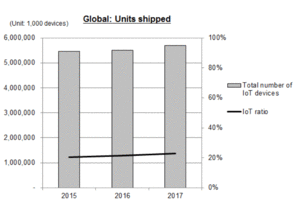
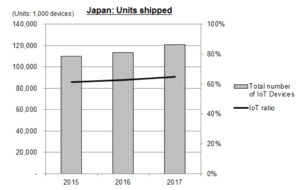
(2) IoT market trends based on the value of IoT devices shipped
- The value of IoT devices shipped (2015) was 602.2 billion U.S. dollars globally and 32.5 billion U.S. dollars for Japan, which accounts for approximately 5% of the global figure.
Diagram 3: IoT market trends based on the value of IoT devices shipped
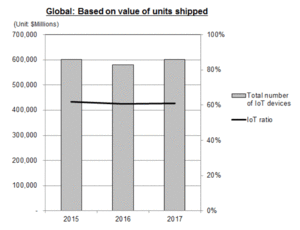
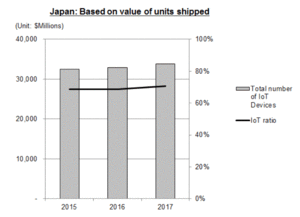
(3) IoT market trends based on the value of IoT devices shipped by category
- The global IoT device market, by the value of shipments, is expected to remain flat, with growth in the value of consumer and industrial use categories not enough to make up for the rapid decline in the price of communication terminals, namely mobile phones and smartphones, as well as the shrinking communication infrastructure market, as technology shifts from 2G to 4G. The drop in price of communication terminals in Japan is not as sharp as in the rest of the world, thus, the value of shipments is increasing for the country. Terminals and infrastructure equipment optimized for the shift to new technologies, such as 5G, should push both the global and Japanese markets into positive growth from 2018 onwards.
- PC-related equipment and printers currently make up a large share of the consumer category in both Japan and the rest of the world, with a high IoT ratio and not much change expected in total value. If PC-related equipment and printers are excluded, the global IoT ratio in this category is currently low. However, the strong push in connected smart appliances from 2016 onwards and the further embrace of wearable health monitoring devices as people become more health conscious should have a positive impact on market growth and advances in IoT.
- The high IoT ratio in industrial uses is led by its application in smart vending machines. The IoT ratio of lighting and security equipment (digital locks, physical security equipment, monitoring cameras) in both the global and Japanese markets is low, but is expected to grow rapidly with the spread of intelligent networks, real-time production management, production-site monitoring for energy conservation and security initiatives (This year’s study did not cover factory automation and IoT compatibility of retail/logistic equipment, which are still expected to be of limited use).
- In the automobile category, Japan leads in the IoT ratio (nearing the figure for communications) with the spread of on-board car navigation systems and ETC (cashless tolls). Progress in IoT and growth of the market is projected for global and Japanese markets with advances in the connected car.
- In healthcare, the spread of electronic medical records and remote medicine has pushed the IoT ratio to 20%, with room for further growth as personal healthcare devices, such as blood pressure monitoring devices, and advanced clinical equipment become IoT compatible.
Diagram 4: IoT market trends based on IoT devices category
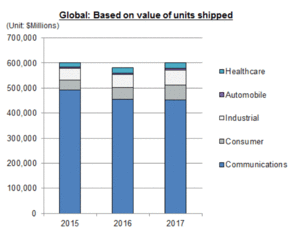
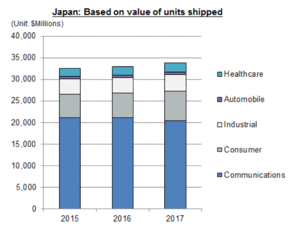
Diagram 5: IoT market trends based on IoT ratio of IoT device categories
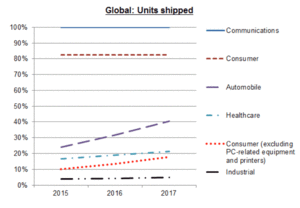
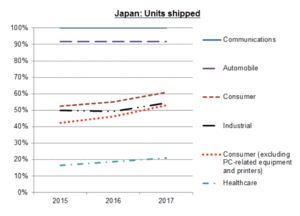
4. Conclusion
This year’s study was focused on equipment and hardware, but in the number of units shipped, the IoT device market is growing, with the value also expected to increase. The growth is also expected to be fueled by new technologies. With a low IoT ratio of about 20%, the global IoT market especially holds potential for Japanese manufacturers in the area of exports. Gaining an accurate grasp of the progress in IoT will allow ICT to resolve social challenges and create new markets.
In addition, a separate study has found the cloud business to be growing at approximately 50% in value and can be expected to further the growth in IoT. With this in mind, CIAJ will consider expanding the scope of the service category in the 2017 study.
Note
- This year’s report was compiled by CIAJ’s Research and Statistics Sub-committee and the Market Research and Statistics Department with the cooperation of IHS Global.
- The Report is available for CIAJ members and is accessible via the member portal site (in Japanese only).
For details, contact
Market Research
CIAJ
tel: 81-3-5403-9356 fax: 81-3-5403-9360
For more general inquiries, contact
Corporate Communications
CIAJ
tel: 81-3-5403-9351 fax: 81-3-5403-9360
